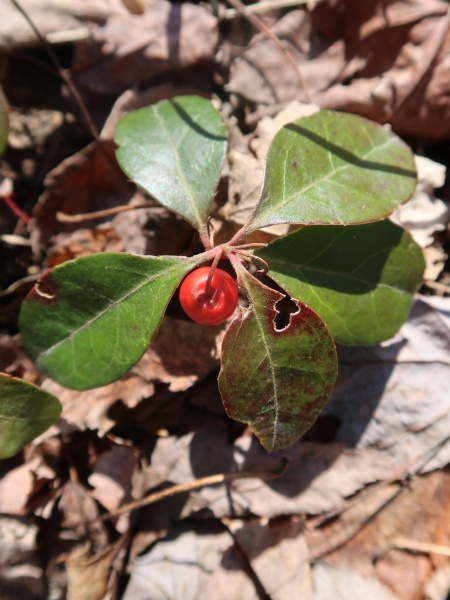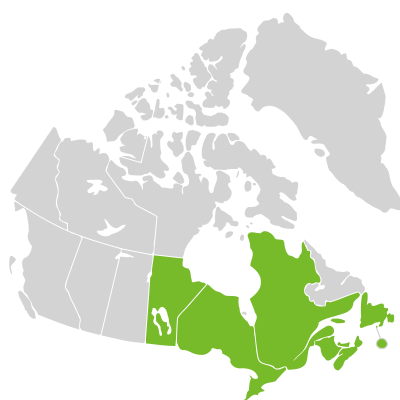
Source: OWSL
Gaultheria procumbens
Eastern Teaberry
Thé des bois
Synonyms
checkerberry
creeping wintergreen
eastern wintergreen
spring wintergreen
wintergreen
gaulthérie couchée
petit thé
pommes de terre
thé rouge
No seeds available for this plant.
We currently accept seeds for this plant
Bloom Colour: White
Bloom Period: Jun - Jul
Max Height: 0.5 feet
Max Width: 1.0 feet (spreads by rhizome)
Light Condition:
 Less than 2 or 3 hours of direct sun a day
Soil conditions:
Less than 2 or 3 hours of direct sun a day
Soil conditions:
 Tolerates medium soil condition
Tolerates medium soil condition
 Less than 2 or 3 hours of direct sun a day
Less than 2 or 3 hours of direct sun a day
 Tolerates medium soil condition
Tolerates medium soil condition
Lifespan:
Perennial
plants that will that come back year after year
Plant is
dioecious
Need a male and female plant to produce seeds
Gardener Experience:
 Does not spread uncontrollably
Does not spread uncontrollably
 Does not spread uncontrollably
Does not spread uncontrollably
Landscape Uses:
 Suitable for container garden
Suitable for container garden
 Suitable for woodland gardens
Suitable for woodland gardens
 Suitable for container garden
Suitable for container garden
 Suitable for woodland gardens
Suitable for woodland gardens
Ecological Benefits:
No ecological benefits information available.
Tolerates:
 Deer resistant
Deer resistant
 Rabbit resistant
Rabbit resistant
 Tolerates acidic soil conditions
Tolerates acidic soil conditions
 Tolerates juglone conditions
Tolerates juglone conditions
 Deer resistant
Deer resistant
 Rabbit resistant
Rabbit resistant
 Tolerates acidic soil conditions
Tolerates acidic soil conditions
 Tolerates juglone conditions
Tolerates juglone conditions
Special Features and Considerations:
 This plant is septic tank safe
This plant is septic tank safe
 This plant is septic tank safe
This plant is septic tank safe
Plant Location
Native to Ottawa region: Yes
Distribution according to VASCAN

Ephemeral
Native
Introduced
Excluded
Extirpated
Doubtful
Absent
Thrives in Ecozones
- Atlantic Maritime
- Boreal Shield
- Mixed Wood Plains
Ecological Benefits
Butterflies Supported by Gaultheria procumbens
No butterfly data available for this plant.
Specialized Bees Supported by Gaultheria procumbens
No bee data available for this plant.
Plants that grow in similar conditions, that bloom at the same time.
Complementary Plants
- Anemone parviflora
Small-flowered Anemone
Anémone à petites fleurs - Erythronium albidum
White Trout Lily
Érythrone blanchâtre - Trillium erectum
Red Trillium
Trille rouge - Trillium grandiflorum
White Trillium
Trille blanc - Viola sororia
Woolly Blue Violet
Violette parente
Substitute For Non-Native Plants
- Ajuga reptans (Bugleweed)
- Convallaria majalis (Lily of the Valley)
- Lysimachia nummularia (Creeping Jenny)
- Iridaceae (Crocus)
- Scilla siberica (Siberian Squill)
- Salvia (Non-Native Sage)
- Vinca major and Vinca minor (Periwinkle)
Sowing Information
Download Seed Envelope Labels (PDF)
- Sowing depth: Surface sow
- Sow by January
- Stratification duration: 90 days
Harvesting and Seed Sharing
- Harvest start month: September
- Harvesting indicator:
- Berries are ripen and easily fall off or have fallen off
- Harvesting:
- Squeeze berries to extract seeds, wash with soapy water, rinse throroughly
- Seed viability test:
- No test needed before donating
- Packaging measure: A dozen (12) seeds (eyeball)
- Seed storage:
- Air dry in paper bag or open container, for a few days until crisp
- Shake seeds to move them once in a while to prevent molding
- Cultivar: Yes, do not donate unless you know source, and there are no known cultivars in your garden or at proximity
- No harvesting video available at this time.
Toxicity Notes
Toxic to mammals if ingested.


 Canadensis
Canadensis
